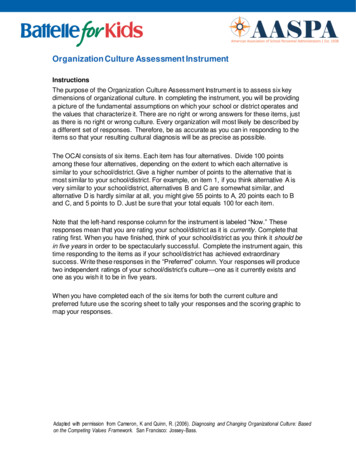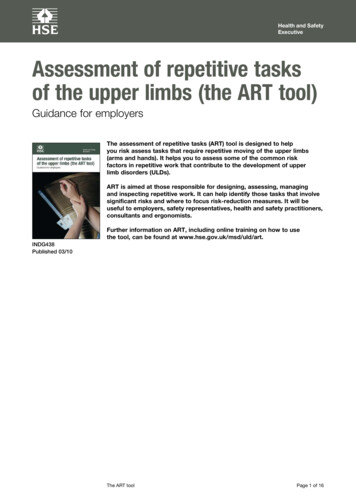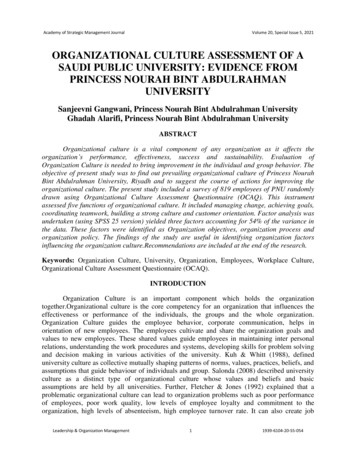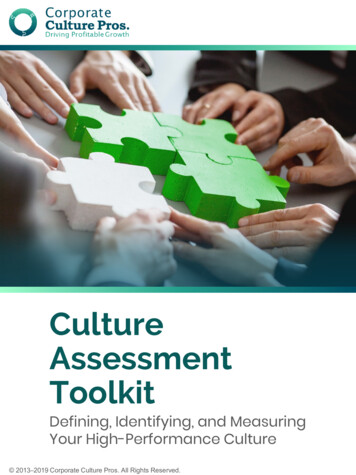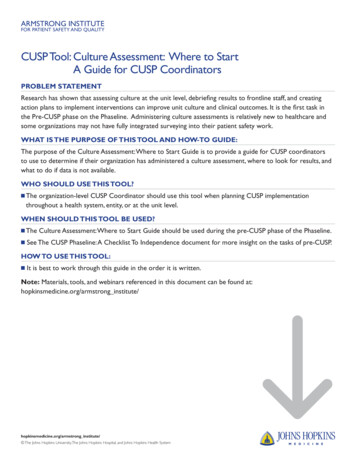
Transcription
ARMSTRONG INSTITUTEFOR PATIENT SAFETY AND QUALITYCUSP Tool: Culture Assessment: Where to StartA Guide for CUSP CoordinatorsPROBLEM STATEMENTResearch has shown that assessing culture at the unit level, debriefing results to frontline staff, and creatingaction plans to implement interventions can improve unit culture and clinical outcomes. It is the first task inthe Pre-CUSP phase on the Phaseline. Administering culture assessments is relatively new to healthcare andsome organizations may not have fully integrated surveying into their patient safety work.WHAT IS THE PURPOSE OF THIS TOOL AND HOW-TO GUIDE:The purpose of the Culture Assessment: Where to Start Guide is to provide a guide for CUSP coordinatorsto use to determine if their organization has administered a culture assessment, where to look for results, andwhat to do if data is not available.WHO SHOULD USE THIS TOOL?n Theorganization-level CUSP Coordinator should use this tool when planning CUSP implementationthroughout a health system, entity, or at the unit level.WHEN SHOULD THIS TOOL BE USED?n ThenCulture Assessment: Where to Start Guide should be used during the pre-CUSP phase of the Phaseline. See The CUSP Phaseline: A Checklist To Independence document for more insight on the tasks of pre-CUSP.HOW TO USE THIS TOOL:n It is best to work through this guide in the order it is written.Note: Materials, tools, and webinars referenced in this document can be found at:hopkinsmedicine.org/armstrong institute/hopkinsmedicine.org/armstrong institute/ The Johns Hopkins University, The Johns Hopkins Hospital, and Johns Hopkins Health System
WHERE TO LOOK FOR CULTURE OF SAFETYASSESSMENT DATAn Ifyou are not sure whether your organization, department, or unit hasadministered a culture of safety assessment to date (e.g., a survey orquestionnaire completed by clinicians and staff), we suggest double-checkingwith the following departments. entral patient safety, quality improvement, or performanceCimprovement department Department Unitnurse manager Departmentor Division administrator Askand organization human resourcesthese questions: W asa culture assessment administered to unit X, or to thedepartment or organization? W ereculture domains on safety and teamwork and other itemsincluded in other surveys, such as an employment satisfaction survey? (For examples of questions see the CUSPCoaching Session:Culture Matters: Measuring and Improving Patient Safety) M ayI have a copy of the instrument, survey, or tool used to assessour culture of safety? (You should know and become familiar with the survey administered). I sthe data available and at what level (organization, department,or unit)? W henwas the survey administered? W ithwhom should I work to obtain the data or a data report forour work area? W ereresults of safety culture assessment discussed or fed back tofrontline clinicians and staff in our work area? (i.e., Were frontlineclinicians and staff who may have taken the survey debriefed on theresults or were results shared with them in some way?)CULTURE ASSESSMENT: WHERE TO STARTA GUIDE FOR CUSP COORDINATORShopkinsmedicine.org/armstrong institute/ The Johns Hopkins University, The Johns Hopkins Hospital, and Johns Hopkins Health System2
STEP 2WHAT IF YOU FIND THAT THERE IS UNIT-LEVEL DATA?n Gatherall the data and reports for your work area.n Ensurethat you know which instrument was used to measure the cultureof safety and become familiar with it.n Determinewhether results were debriefed, discussed, or otherwise fedback to frontline staff. If not, utilizethe “Culture Check-up Tool” to debrief results to frontlinestaff before moving on to the next Pre-CUSP steps in the Phaseline.STEP 3WHAT IF YOU FIND THAT A CULTURE ASSESSMENT WASADMINISTERED AT THE ORGANIZATION OR DEPARTMENTLEVEL, BUT NOT THE UNIT LEVEL?n Ifit was administered at the organization or department level and data areavailable then: btain a copy of the safety culture assessment results report for yourOdepartment. Though these results may roll up data from other workareas it provides a starting point for checking up on the current safetyculture in your work area. ebrief the data with the unit’s frontline staff using the “Culture Check-upDTool.” Try to determine if the data is representative of how the unit stafffeels. Debriefing is very important with higher-level data. Ask frontlineclinicians and staff to discuss if the results from the department or organization align with how they view safety culture in their work area.CULTURE ASSESSMENT: WHERE TO STARTA GUIDE FOR CUSP COORDINATORShopkinsmedicine.org/armstrong institute/ The Johns Hopkins University, The Johns Hopkins Hospital, and Johns Hopkins Health System3
STEP 4WHAT IF YOU HAVE DATA AT ANY LEVEL, BUT IT IS 12 MONTHS OLD?n Followthe advice in Step 2. In this case it is very important to debrief thedata again with the unit’s frontline staff to determine whether it still reflectsthe perceptions of staff on the unit. Remember that any survey capturesdata from a snapshot in time. All debriefing is important but even more so ifdata are old or not at the unit level.STEP 5WHAT IF YOU FIND THAT A CULTURE ASSESSMENT HAS NOTBEEN ADMINISTERED AT ANY LEVEL AND YOU WOULD LIKETO MOVE FORWARD WITH IMPLEMENTING CUSP IN A UNIT?n Ifa culture assessment has not been administered then we recommendthe following: etermine whether your organization is planning to administer a cultureDassessment in the future. If so, when? I f the organization is not planning to administer an assessment in thenear future consider reviewing the peer-reviewed articles below tobecome familiar with the survey instruments available. M anyinstruments are available in the public domain for free. Somesurveys also offer toolkits to support you in collating your data andgenerating a report of your results. Many private vendors also offerservices related to administering and analyzing such survey data. etermine whether you would like to administer a survey and if youDhave the time and resources to do so.n PeerReviewed Articles to Consider: ual Saf Health Care. 2005 Oct;14(5):364-6. Measuring patient safetyQclimate: a review of surveys. Colla JB, Bracken AC, Kinney LM, Weeks WB. ual Saf Health Care. 2006 April; 15(2): 109–115. Measuring safetyQclimate in health care, R Flin, C Burns, K Mearns, S Yule, and E MRobertson urr Opin Crit Care. 2010 Dec;16(6):632-8. Hospital safety climateCsurveys: measurement issues. Jackson J, Sarac C, Flin R.hopkinsmedicine.org/armstrong institute/ The Johns Hopkins University, The Johns Hopkins Hospital, and Johns Hopkins Health SystemCULTURE ASSESSMENT: WHERE TO STARTA GUIDE FOR CUSP COORDINATORS4
STEP 6WHAT IF YOU DECIDE THAT ADMINISTERING A SURVEY ISNOT POSSIBLE AT THIS TIME?n Youwill still want to explore some of your unit’s safety culture strengthsand weaknesses qualitatively. One way to do this is through conversations with frontline clinicians, staff, and leaders. In a morning huddle, staffmeetings, or one-on-one conversations, you may want to ask your teammembers to: I magine that we are going to work on optimizing safety in our work area(provide some examples of recent patient safety threats or events here asneeded, or examples of things that might be targeted for improvement). W hataspects of our unit and how we work together currently mightinfluence the success of these efforts to improve safety (i.e., what thingsmight help this effort be a success and what things might keep theseefforts from being successful in improving safety for our patients)?STEP 7WHAT NEXT?n Afterfollowing the steps above, determine the cultural health of your unit. I f you did formally administer a culture assessment, determine if resultswere in the danger zone or goal zone for the instrument used I f you did not formally administer a culture assessment but rather askedquestions in Step 6 above, get a feel for whether your unit has a strongsafety culture I t is advisable to review the CUSPCoaching Session, CUSP How doyou know if you are ready? for advice on moving forward with CUSPImplementation utilizing the Phaseline.CULTURE ASSESSMENT: WHERE TO STARTA GUIDE FOR CUSP COORDINATORShopkinsmedicine.org/armstrong institute/ The Johns Hopkins University, The Johns Hopkins Hospital, and Johns Hopkins Health System5
Research has shown that assessing culture at the unit level, debriefing results to frontline staff, and creating action plans to implement interventions can improve unit culture and clinical outcomes. It is the first task in . the Pre-CUSP phase on the Phaseline. Administering culture assessments is relatively new to healthcare and






